Teaching in a Specialist Area
VerifiedAdded on 2021/02/19
|15
|3177
|41
AI Summary
Contribute Materials
Your contribution can guide someone’s learning journey. Share your
documents today.
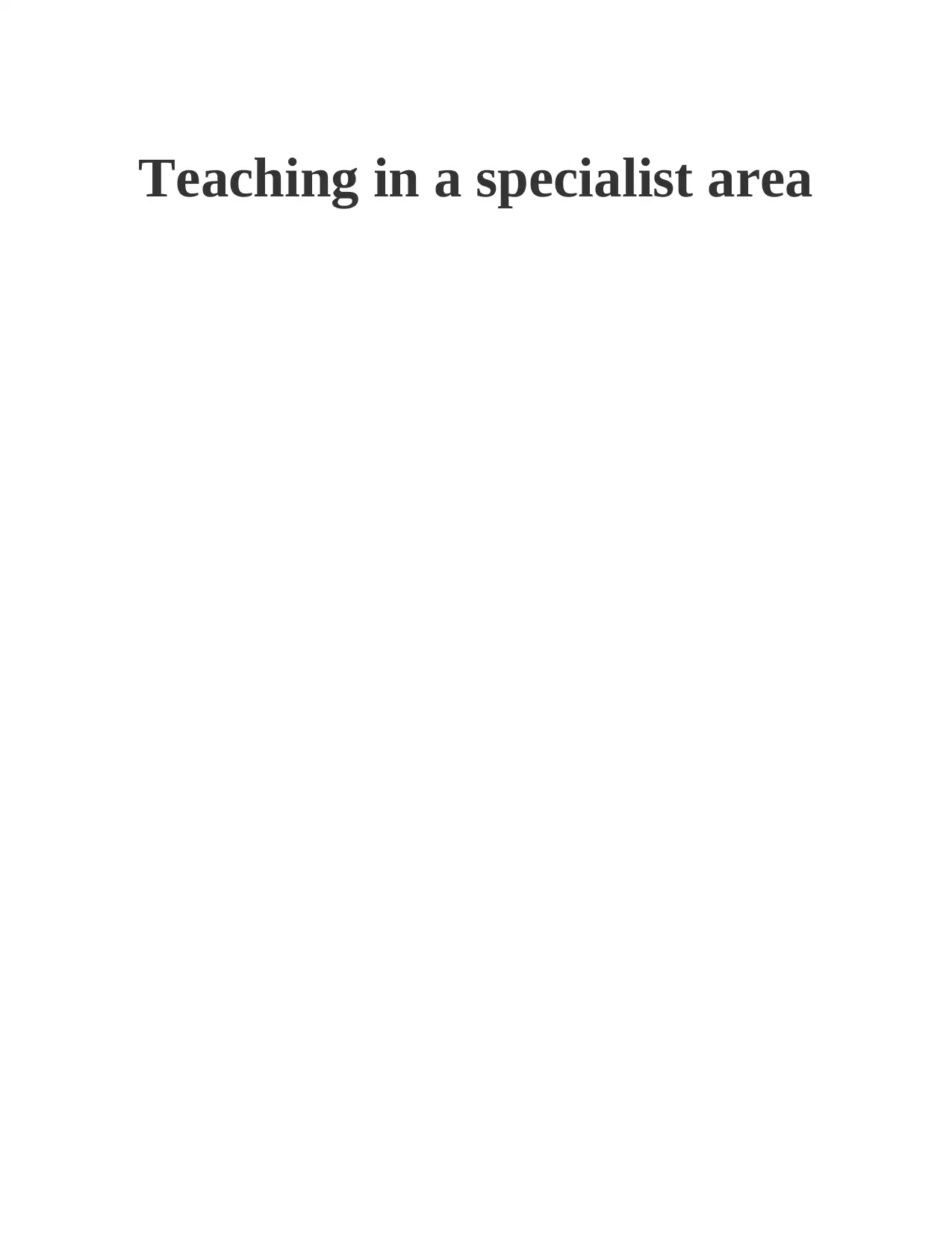
Teaching in a specialist area
Secure Best Marks with AI Grader
Need help grading? Try our AI Grader for instant feedback on your assignments.

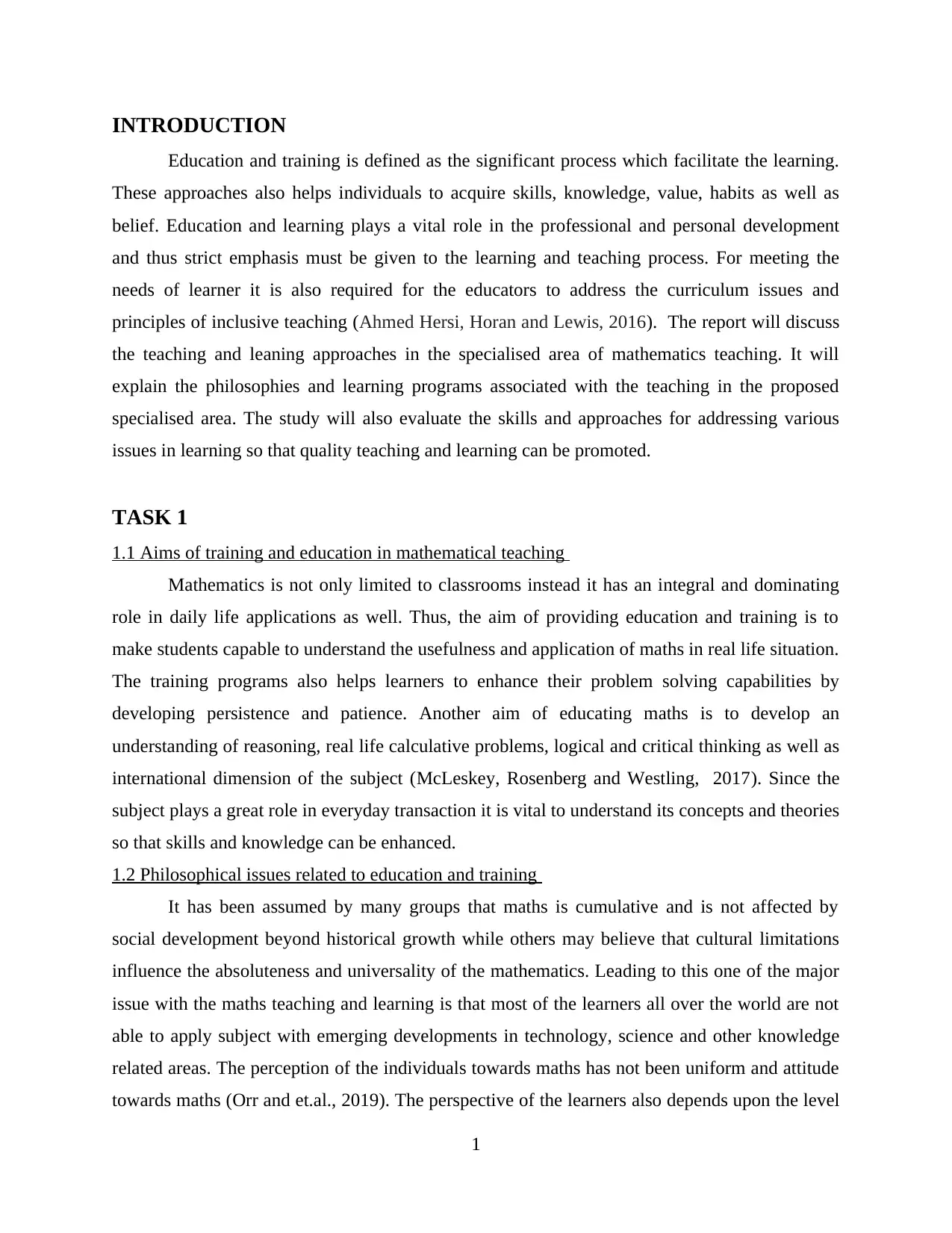
INTRODUCTION
Education and training is defined as the significant process which facilitate the learning.
These approaches also helps individuals to acquire skills, knowledge, value, habits as well as
belief. Education and learning plays a vital role in the professional and personal development
and thus strict emphasis must be given to the learning and teaching process. For meeting the
needs of learner it is also required for the educators to address the curriculum issues and
principles of inclusive teaching (Ahmed Hersi, Horan and Lewis, 2016). The report will discuss
the teaching and leaning approaches in the specialised area of mathematics teaching. It will
explain the philosophies and learning programs associated with the teaching in the proposed
specialised area. The study will also evaluate the skills and approaches for addressing various
issues in learning so that quality teaching and learning can be promoted.
TASK 1
1.1 Aims of training and education in mathematical teaching
Mathematics is not only limited to classrooms instead it has an integral and dominating
role in daily life applications as well. Thus, the aim of providing education and training is to
make students capable to understand the usefulness and application of maths in real life situation.
The training programs also helps learners to enhance their problem solving capabilities by
developing persistence and patience. Another aim of educating maths is to develop an
understanding of reasoning, real life calculative problems, logical and critical thinking as well as
international dimension of the subject (McLeskey, Rosenberg and Westling, 2017). Since the
subject plays a great role in everyday transaction it is vital to understand its concepts and theories
so that skills and knowledge can be enhanced.
1.2 Philosophical issues related to education and training
It has been assumed by many groups that maths is cumulative and is not affected by
social development beyond historical growth while others may believe that cultural limitations
influence the absoluteness and universality of the mathematics. Leading to this one of the major
issue with the maths teaching and learning is that most of the learners all over the world are not
able to apply subject with emerging developments in technology, science and other knowledge
related areas. The perception of the individuals towards maths has not been uniform and attitude
towards maths (Orr and et.al., 2019). The perspective of the learners also depends upon the level
1
Education and training is defined as the significant process which facilitate the learning.
These approaches also helps individuals to acquire skills, knowledge, value, habits as well as
belief. Education and learning plays a vital role in the professional and personal development
and thus strict emphasis must be given to the learning and teaching process. For meeting the
needs of learner it is also required for the educators to address the curriculum issues and
principles of inclusive teaching (Ahmed Hersi, Horan and Lewis, 2016). The report will discuss
the teaching and leaning approaches in the specialised area of mathematics teaching. It will
explain the philosophies and learning programs associated with the teaching in the proposed
specialised area. The study will also evaluate the skills and approaches for addressing various
issues in learning so that quality teaching and learning can be promoted.
TASK 1
1.1 Aims of training and education in mathematical teaching
Mathematics is not only limited to classrooms instead it has an integral and dominating
role in daily life applications as well. Thus, the aim of providing education and training is to
make students capable to understand the usefulness and application of maths in real life situation.
The training programs also helps learners to enhance their problem solving capabilities by
developing persistence and patience. Another aim of educating maths is to develop an
understanding of reasoning, real life calculative problems, logical and critical thinking as well as
international dimension of the subject (McLeskey, Rosenberg and Westling, 2017). Since the
subject plays a great role in everyday transaction it is vital to understand its concepts and theories
so that skills and knowledge can be enhanced.
1.2 Philosophical issues related to education and training
It has been assumed by many groups that maths is cumulative and is not affected by
social development beyond historical growth while others may believe that cultural limitations
influence the absoluteness and universality of the mathematics. Leading to this one of the major
issue with the maths teaching and learning is that most of the learners all over the world are not
able to apply subject with emerging developments in technology, science and other knowledge
related areas. The perception of the individuals towards maths has not been uniform and attitude
towards maths (Orr and et.al., 2019). The perspective of the learners also depends upon the level
1
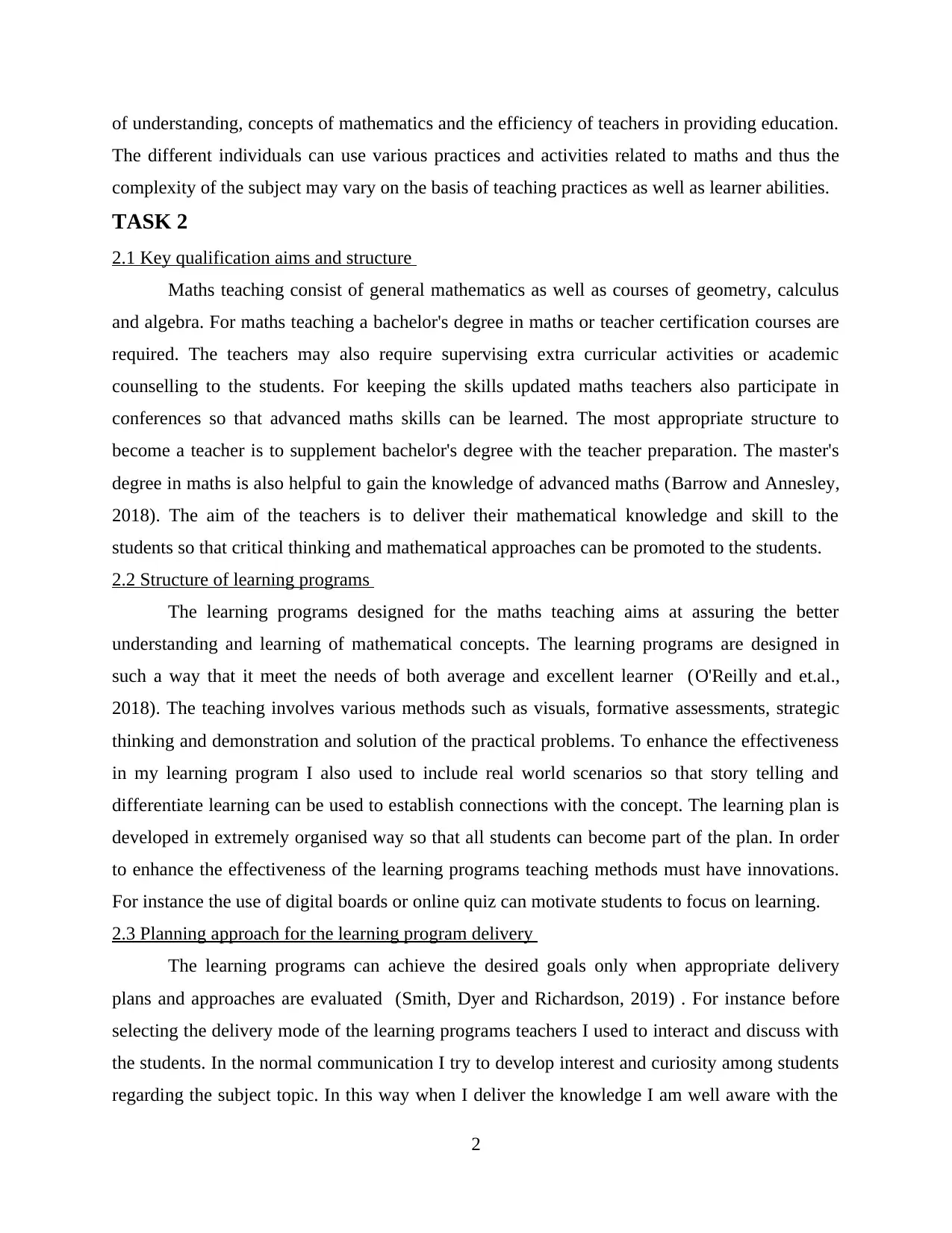
of understanding, concepts of mathematics and the efficiency of teachers in providing education.
The different individuals can use various practices and activities related to maths and thus the
complexity of the subject may vary on the basis of teaching practices as well as learner abilities.
TASK 2
2.1 Key qualification aims and structure
Maths teaching consist of general mathematics as well as courses of geometry, calculus
and algebra. For maths teaching a bachelor's degree in maths or teacher certification courses are
required. The teachers may also require supervising extra curricular activities or academic
counselling to the students. For keeping the skills updated maths teachers also participate in
conferences so that advanced maths skills can be learned. The most appropriate structure to
become a teacher is to supplement bachelor's degree with the teacher preparation. The master's
degree in maths is also helpful to gain the knowledge of advanced maths (Barrow and Annesley,
2018). The aim of the teachers is to deliver their mathematical knowledge and skill to the
students so that critical thinking and mathematical approaches can be promoted to the students.
2.2 Structure of learning programs
The learning programs designed for the maths teaching aims at assuring the better
understanding and learning of mathematical concepts. The learning programs are designed in
such a way that it meet the needs of both average and excellent learner (O'Reilly and et.al.,
2018). The teaching involves various methods such as visuals, formative assessments, strategic
thinking and demonstration and solution of the practical problems. To enhance the effectiveness
in my learning program I also used to include real world scenarios so that story telling and
differentiate learning can be used to establish connections with the concept. The learning plan is
developed in extremely organised way so that all students can become part of the plan. In order
to enhance the effectiveness of the learning programs teaching methods must have innovations.
For instance the use of digital boards or online quiz can motivate students to focus on learning.
2.3 Planning approach for the learning program delivery
The learning programs can achieve the desired goals only when appropriate delivery
plans and approaches are evaluated (Smith, Dyer and Richardson, 2019) . For instance before
selecting the delivery mode of the learning programs teachers I used to interact and discuss with
the students. In the normal communication I try to develop interest and curiosity among students
regarding the subject topic. In this way when I deliver the knowledge I am well aware with the
2
The different individuals can use various practices and activities related to maths and thus the
complexity of the subject may vary on the basis of teaching practices as well as learner abilities.
TASK 2
2.1 Key qualification aims and structure
Maths teaching consist of general mathematics as well as courses of geometry, calculus
and algebra. For maths teaching a bachelor's degree in maths or teacher certification courses are
required. The teachers may also require supervising extra curricular activities or academic
counselling to the students. For keeping the skills updated maths teachers also participate in
conferences so that advanced maths skills can be learned. The most appropriate structure to
become a teacher is to supplement bachelor's degree with the teacher preparation. The master's
degree in maths is also helpful to gain the knowledge of advanced maths (Barrow and Annesley,
2018). The aim of the teachers is to deliver their mathematical knowledge and skill to the
students so that critical thinking and mathematical approaches can be promoted to the students.
2.2 Structure of learning programs
The learning programs designed for the maths teaching aims at assuring the better
understanding and learning of mathematical concepts. The learning programs are designed in
such a way that it meet the needs of both average and excellent learner (O'Reilly and et.al.,
2018). The teaching involves various methods such as visuals, formative assessments, strategic
thinking and demonstration and solution of the practical problems. To enhance the effectiveness
in my learning program I also used to include real world scenarios so that story telling and
differentiate learning can be used to establish connections with the concept. The learning plan is
developed in extremely organised way so that all students can become part of the plan. In order
to enhance the effectiveness of the learning programs teaching methods must have innovations.
For instance the use of digital boards or online quiz can motivate students to focus on learning.
2.3 Planning approach for the learning program delivery
The learning programs can achieve the desired goals only when appropriate delivery
plans and approaches are evaluated (Smith, Dyer and Richardson, 2019) . For instance before
selecting the delivery mode of the learning programs teachers I used to interact and discuss with
the students. In the normal communication I try to develop interest and curiosity among students
regarding the subject topic. In this way when I deliver the knowledge I am well aware with the
2
Secure Best Marks with AI Grader
Need help grading? Try our AI Grader for instant feedback on your assignments.
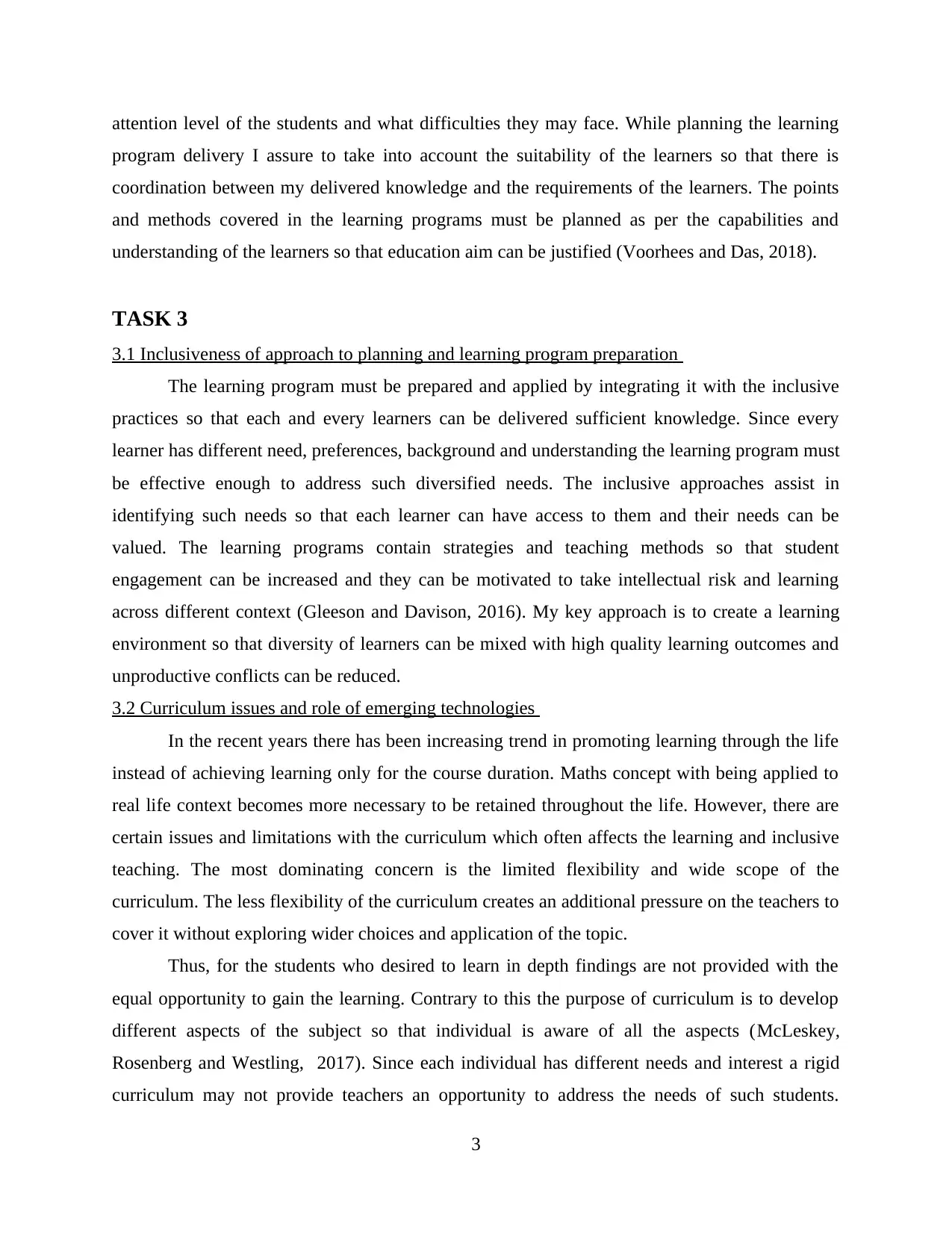
attention level of the students and what difficulties they may face. While planning the learning
program delivery I assure to take into account the suitability of the learners so that there is
coordination between my delivered knowledge and the requirements of the learners. The points
and methods covered in the learning programs must be planned as per the capabilities and
understanding of the learners so that education aim can be justified (Voorhees and Das, 2018).
TASK 3
3.1 Inclusiveness of approach to planning and learning program preparation
The learning program must be prepared and applied by integrating it with the inclusive
practices so that each and every learners can be delivered sufficient knowledge. Since every
learner has different need, preferences, background and understanding the learning program must
be effective enough to address such diversified needs. The inclusive approaches assist in
identifying such needs so that each learner can have access to them and their needs can be
valued. The learning programs contain strategies and teaching methods so that student
engagement can be increased and they can be motivated to take intellectual risk and learning
across different context (Gleeson and Davison, 2016). My key approach is to create a learning
environment so that diversity of learners can be mixed with high quality learning outcomes and
unproductive conflicts can be reduced.
3.2 Curriculum issues and role of emerging technologies
In the recent years there has been increasing trend in promoting learning through the life
instead of achieving learning only for the course duration. Maths concept with being applied to
real life context becomes more necessary to be retained throughout the life. However, there are
certain issues and limitations with the curriculum which often affects the learning and inclusive
teaching. The most dominating concern is the limited flexibility and wide scope of the
curriculum. The less flexibility of the curriculum creates an additional pressure on the teachers to
cover it without exploring wider choices and application of the topic.
Thus, for the students who desired to learn in depth findings are not provided with the
equal opportunity to gain the learning. Contrary to this the purpose of curriculum is to develop
different aspects of the subject so that individual is aware of all the aspects (McLeskey,
Rosenberg and Westling, 2017). Since each individual has different needs and interest a rigid
curriculum may not provide teachers an opportunity to address the needs of such students.
3
program delivery I assure to take into account the suitability of the learners so that there is
coordination between my delivered knowledge and the requirements of the learners. The points
and methods covered in the learning programs must be planned as per the capabilities and
understanding of the learners so that education aim can be justified (Voorhees and Das, 2018).
TASK 3
3.1 Inclusiveness of approach to planning and learning program preparation
The learning program must be prepared and applied by integrating it with the inclusive
practices so that each and every learners can be delivered sufficient knowledge. Since every
learner has different need, preferences, background and understanding the learning program must
be effective enough to address such diversified needs. The inclusive approaches assist in
identifying such needs so that each learner can have access to them and their needs can be
valued. The learning programs contain strategies and teaching methods so that student
engagement can be increased and they can be motivated to take intellectual risk and learning
across different context (Gleeson and Davison, 2016). My key approach is to create a learning
environment so that diversity of learners can be mixed with high quality learning outcomes and
unproductive conflicts can be reduced.
3.2 Curriculum issues and role of emerging technologies
In the recent years there has been increasing trend in promoting learning through the life
instead of achieving learning only for the course duration. Maths concept with being applied to
real life context becomes more necessary to be retained throughout the life. However, there are
certain issues and limitations with the curriculum which often affects the learning and inclusive
teaching. The most dominating concern is the limited flexibility and wide scope of the
curriculum. The less flexibility of the curriculum creates an additional pressure on the teachers to
cover it without exploring wider choices and application of the topic.
Thus, for the students who desired to learn in depth findings are not provided with the
equal opportunity to gain the learning. Contrary to this the purpose of curriculum is to develop
different aspects of the subject so that individual is aware of all the aspects (McLeskey,
Rosenberg and Westling, 2017). Since each individual has different needs and interest a rigid
curriculum may not provide teachers an opportunity to address the needs of such students.
3
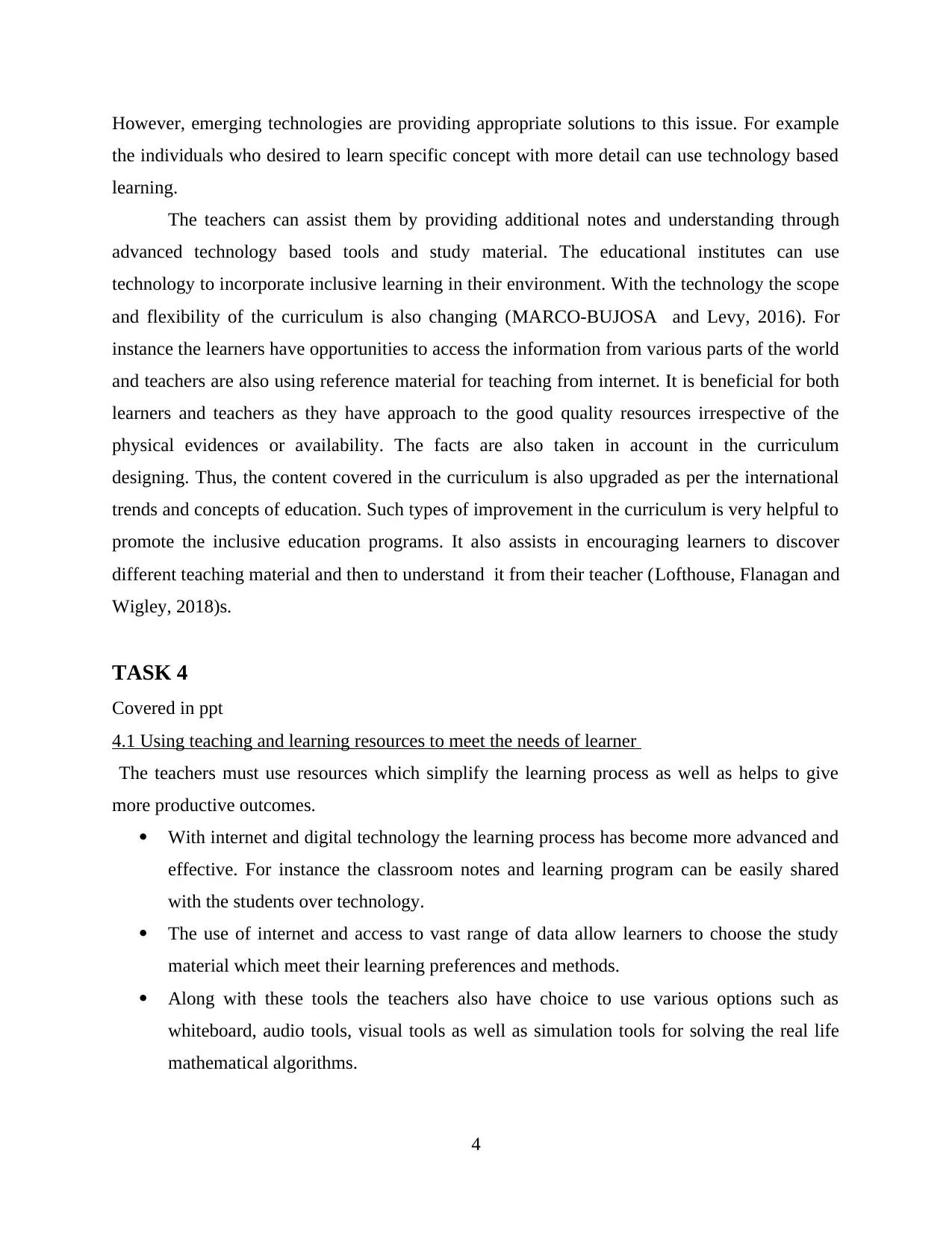
However, emerging technologies are providing appropriate solutions to this issue. For example
the individuals who desired to learn specific concept with more detail can use technology based
learning.
The teachers can assist them by providing additional notes and understanding through
advanced technology based tools and study material. The educational institutes can use
technology to incorporate inclusive learning in their environment. With the technology the scope
and flexibility of the curriculum is also changing (MARCO‐BUJOSA and Levy, 2016). For
instance the learners have opportunities to access the information from various parts of the world
and teachers are also using reference material for teaching from internet. It is beneficial for both
learners and teachers as they have approach to the good quality resources irrespective of the
physical evidences or availability. The facts are also taken in account in the curriculum
designing. Thus, the content covered in the curriculum is also upgraded as per the international
trends and concepts of education. Such types of improvement in the curriculum is very helpful to
promote the inclusive education programs. It also assists in encouraging learners to discover
different teaching material and then to understand it from their teacher (Lofthouse, Flanagan and
Wigley, 2018)s.
TASK 4
Covered in ppt
4.1 Using teaching and learning resources to meet the needs of learner
The teachers must use resources which simplify the learning process as well as helps to give
more productive outcomes.
With internet and digital technology the learning process has become more advanced and
effective. For instance the classroom notes and learning program can be easily shared
with the students over technology.
The use of internet and access to vast range of data allow learners to choose the study
material which meet their learning preferences and methods.
Along with these tools the teachers also have choice to use various options such as
whiteboard, audio tools, visual tools as well as simulation tools for solving the real life
mathematical algorithms.
4
the individuals who desired to learn specific concept with more detail can use technology based
learning.
The teachers can assist them by providing additional notes and understanding through
advanced technology based tools and study material. The educational institutes can use
technology to incorporate inclusive learning in their environment. With the technology the scope
and flexibility of the curriculum is also changing (MARCO‐BUJOSA and Levy, 2016). For
instance the learners have opportunities to access the information from various parts of the world
and teachers are also using reference material for teaching from internet. It is beneficial for both
learners and teachers as they have approach to the good quality resources irrespective of the
physical evidences or availability. The facts are also taken in account in the curriculum
designing. Thus, the content covered in the curriculum is also upgraded as per the international
trends and concepts of education. Such types of improvement in the curriculum is very helpful to
promote the inclusive education programs. It also assists in encouraging learners to discover
different teaching material and then to understand it from their teacher (Lofthouse, Flanagan and
Wigley, 2018)s.
TASK 4
Covered in ppt
4.1 Using teaching and learning resources to meet the needs of learner
The teachers must use resources which simplify the learning process as well as helps to give
more productive outcomes.
With internet and digital technology the learning process has become more advanced and
effective. For instance the classroom notes and learning program can be easily shared
with the students over technology.
The use of internet and access to vast range of data allow learners to choose the study
material which meet their learning preferences and methods.
Along with these tools the teachers also have choice to use various options such as
whiteboard, audio tools, visual tools as well as simulation tools for solving the real life
mathematical algorithms.
4
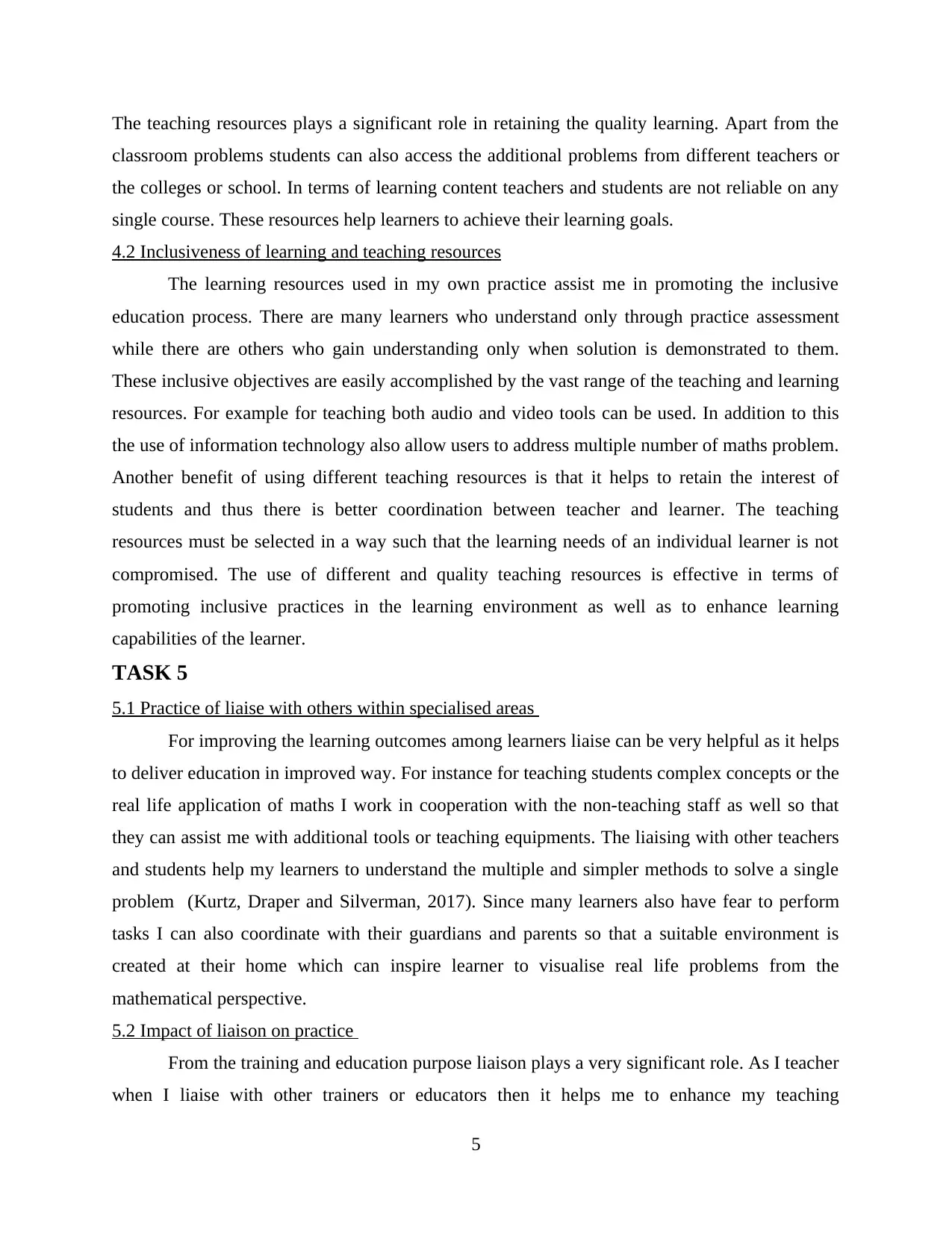
The teaching resources plays a significant role in retaining the quality learning. Apart from the
classroom problems students can also access the additional problems from different teachers or
the colleges or school. In terms of learning content teachers and students are not reliable on any
single course. These resources help learners to achieve their learning goals.
4.2 Inclusiveness of learning and teaching resources
The learning resources used in my own practice assist me in promoting the inclusive
education process. There are many learners who understand only through practice assessment
while there are others who gain understanding only when solution is demonstrated to them.
These inclusive objectives are easily accomplished by the vast range of the teaching and learning
resources. For example for teaching both audio and video tools can be used. In addition to this
the use of information technology also allow users to address multiple number of maths problem.
Another benefit of using different teaching resources is that it helps to retain the interest of
students and thus there is better coordination between teacher and learner. The teaching
resources must be selected in a way such that the learning needs of an individual learner is not
compromised. The use of different and quality teaching resources is effective in terms of
promoting inclusive practices in the learning environment as well as to enhance learning
capabilities of the learner.
TASK 5
5.1 Practice of liaise with others within specialised areas
For improving the learning outcomes among learners liaise can be very helpful as it helps
to deliver education in improved way. For instance for teaching students complex concepts or the
real life application of maths I work in cooperation with the non-teaching staff as well so that
they can assist me with additional tools or teaching equipments. The liaising with other teachers
and students help my learners to understand the multiple and simpler methods to solve a single
problem (Kurtz, Draper and Silverman, 2017). Since many learners also have fear to perform
tasks I can also coordinate with their guardians and parents so that a suitable environment is
created at their home which can inspire learner to visualise real life problems from the
mathematical perspective.
5.2 Impact of liaison on practice
From the training and education purpose liaison plays a very significant role. As I teacher
when I liaise with other trainers or educators then it helps me to enhance my teaching
5
classroom problems students can also access the additional problems from different teachers or
the colleges or school. In terms of learning content teachers and students are not reliable on any
single course. These resources help learners to achieve their learning goals.
4.2 Inclusiveness of learning and teaching resources
The learning resources used in my own practice assist me in promoting the inclusive
education process. There are many learners who understand only through practice assessment
while there are others who gain understanding only when solution is demonstrated to them.
These inclusive objectives are easily accomplished by the vast range of the teaching and learning
resources. For example for teaching both audio and video tools can be used. In addition to this
the use of information technology also allow users to address multiple number of maths problem.
Another benefit of using different teaching resources is that it helps to retain the interest of
students and thus there is better coordination between teacher and learner. The teaching
resources must be selected in a way such that the learning needs of an individual learner is not
compromised. The use of different and quality teaching resources is effective in terms of
promoting inclusive practices in the learning environment as well as to enhance learning
capabilities of the learner.
TASK 5
5.1 Practice of liaise with others within specialised areas
For improving the learning outcomes among learners liaise can be very helpful as it helps
to deliver education in improved way. For instance for teaching students complex concepts or the
real life application of maths I work in cooperation with the non-teaching staff as well so that
they can assist me with additional tools or teaching equipments. The liaising with other teachers
and students help my learners to understand the multiple and simpler methods to solve a single
problem (Kurtz, Draper and Silverman, 2017). Since many learners also have fear to perform
tasks I can also coordinate with their guardians and parents so that a suitable environment is
created at their home which can inspire learner to visualise real life problems from the
mathematical perspective.
5.2 Impact of liaison on practice
From the training and education purpose liaison plays a very significant role. As I teacher
when I liaise with other trainers or educators then it helps me to enhance my teaching
5
Paraphrase This Document
Need a fresh take? Get an instant paraphrase of this document with our AI Paraphraser
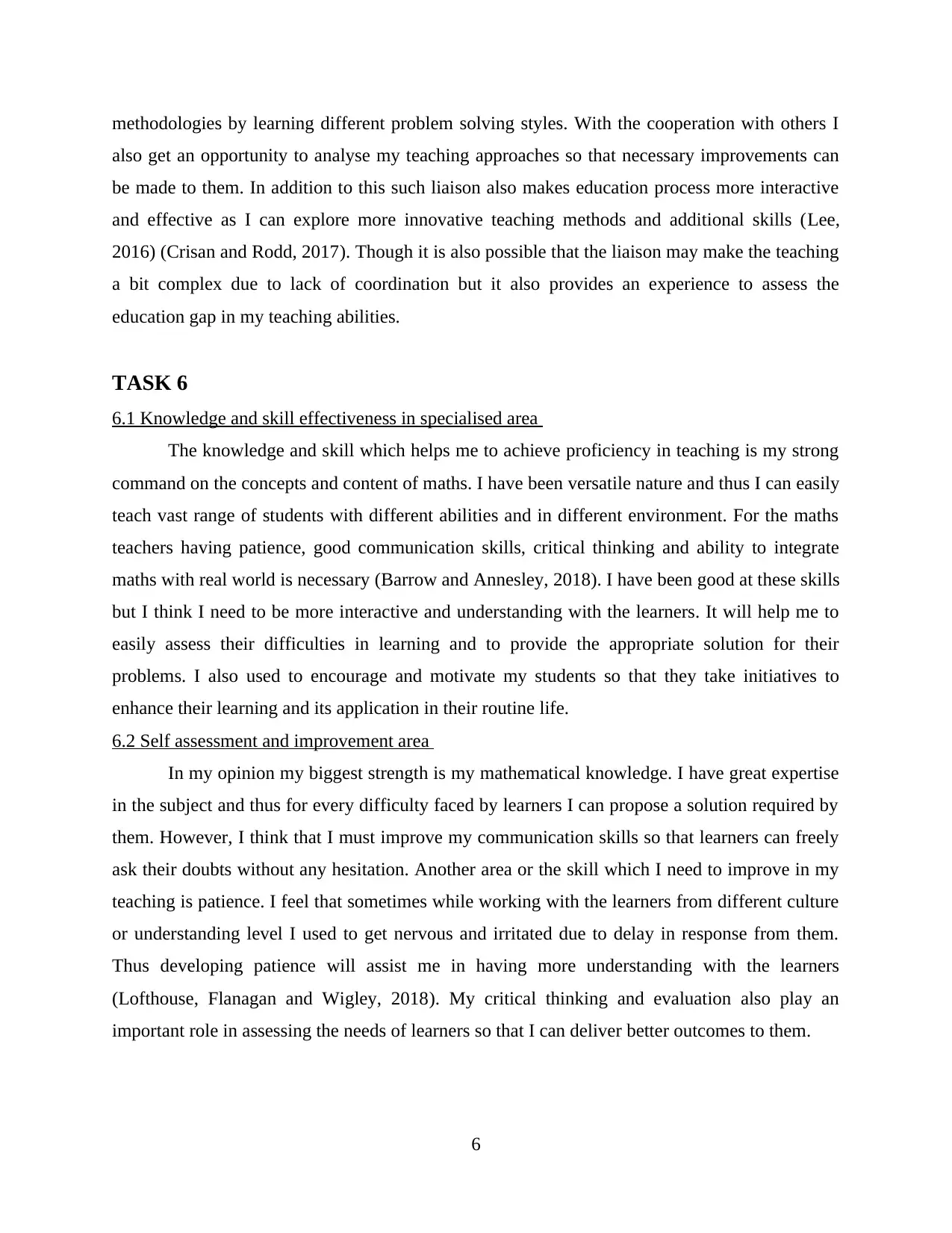
methodologies by learning different problem solving styles. With the cooperation with others I
also get an opportunity to analyse my teaching approaches so that necessary improvements can
be made to them. In addition to this such liaison also makes education process more interactive
and effective as I can explore more innovative teaching methods and additional skills (Lee,
2016) (Crisan and Rodd, 2017). Though it is also possible that the liaison may make the teaching
a bit complex due to lack of coordination but it also provides an experience to assess the
education gap in my teaching abilities.
TASK 6
6.1 Knowledge and skill effectiveness in specialised area
The knowledge and skill which helps me to achieve proficiency in teaching is my strong
command on the concepts and content of maths. I have been versatile nature and thus I can easily
teach vast range of students with different abilities and in different environment. For the maths
teachers having patience, good communication skills, critical thinking and ability to integrate
maths with real world is necessary (Barrow and Annesley, 2018). I have been good at these skills
but I think I need to be more interactive and understanding with the learners. It will help me to
easily assess their difficulties in learning and to provide the appropriate solution for their
problems. I also used to encourage and motivate my students so that they take initiatives to
enhance their learning and its application in their routine life.
6.2 Self assessment and improvement area
In my opinion my biggest strength is my mathematical knowledge. I have great expertise
in the subject and thus for every difficulty faced by learners I can propose a solution required by
them. However, I think that I must improve my communication skills so that learners can freely
ask their doubts without any hesitation. Another area or the skill which I need to improve in my
teaching is patience. I feel that sometimes while working with the learners from different culture
or understanding level I used to get nervous and irritated due to delay in response from them.
Thus developing patience will assist me in having more understanding with the learners
(Lofthouse, Flanagan and Wigley, 2018). My critical thinking and evaluation also play an
important role in assessing the needs of learners so that I can deliver better outcomes to them.
6
also get an opportunity to analyse my teaching approaches so that necessary improvements can
be made to them. In addition to this such liaison also makes education process more interactive
and effective as I can explore more innovative teaching methods and additional skills (Lee,
2016) (Crisan and Rodd, 2017). Though it is also possible that the liaison may make the teaching
a bit complex due to lack of coordination but it also provides an experience to assess the
education gap in my teaching abilities.
TASK 6
6.1 Knowledge and skill effectiveness in specialised area
The knowledge and skill which helps me to achieve proficiency in teaching is my strong
command on the concepts and content of maths. I have been versatile nature and thus I can easily
teach vast range of students with different abilities and in different environment. For the maths
teachers having patience, good communication skills, critical thinking and ability to integrate
maths with real world is necessary (Barrow and Annesley, 2018). I have been good at these skills
but I think I need to be more interactive and understanding with the learners. It will help me to
easily assess their difficulties in learning and to provide the appropriate solution for their
problems. I also used to encourage and motivate my students so that they take initiatives to
enhance their learning and its application in their routine life.
6.2 Self assessment and improvement area
In my opinion my biggest strength is my mathematical knowledge. I have great expertise
in the subject and thus for every difficulty faced by learners I can propose a solution required by
them. However, I think that I must improve my communication skills so that learners can freely
ask their doubts without any hesitation. Another area or the skill which I need to improve in my
teaching is patience. I feel that sometimes while working with the learners from different culture
or understanding level I used to get nervous and irritated due to delay in response from them.
Thus developing patience will assist me in having more understanding with the learners
(Lofthouse, Flanagan and Wigley, 2018). My critical thinking and evaluation also play an
important role in assessing the needs of learners so that I can deliver better outcomes to them.
6
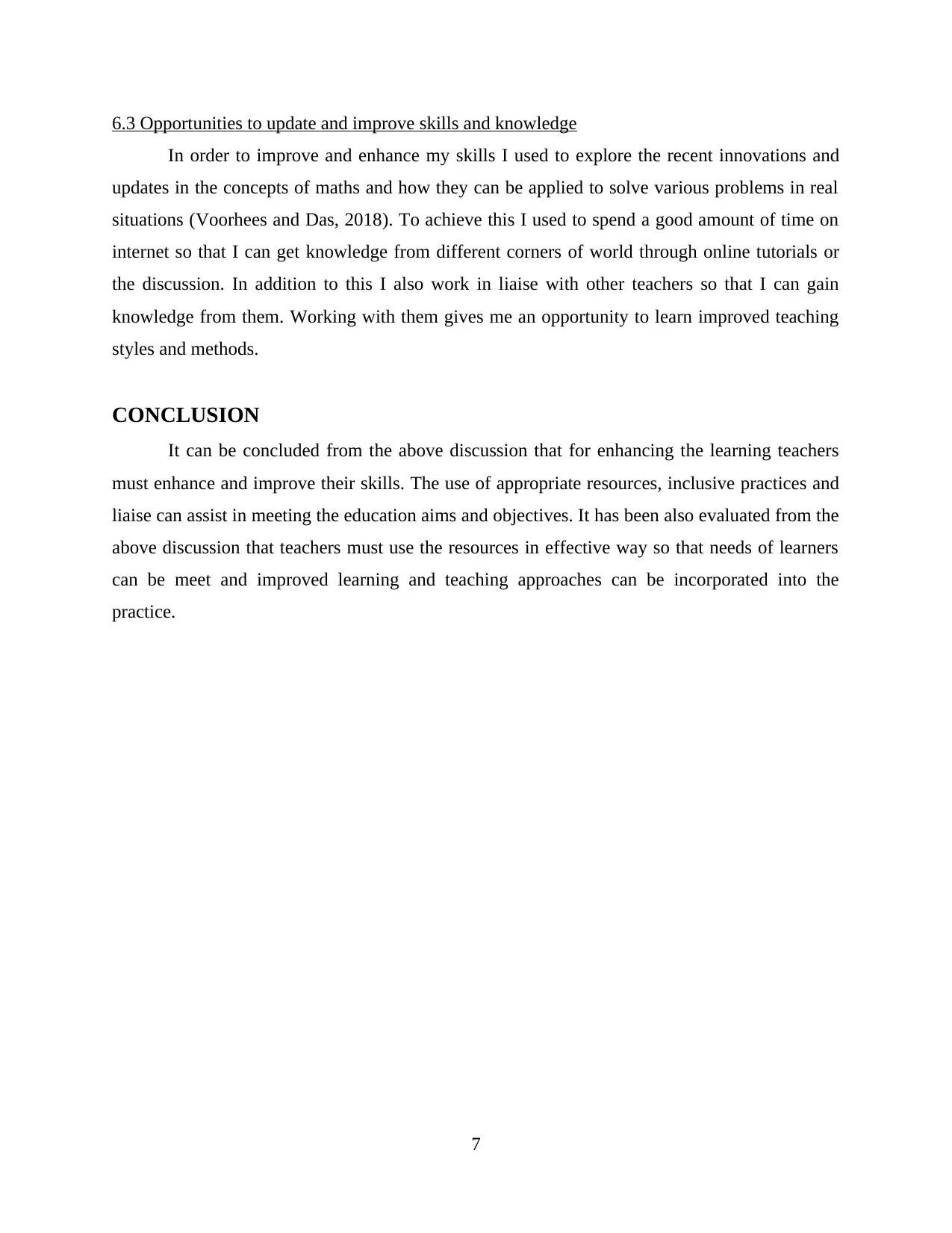
6.3 Opportunities to update and improve skills and knowledge
In order to improve and enhance my skills I used to explore the recent innovations and
updates in the concepts of maths and how they can be applied to solve various problems in real
situations (Voorhees and Das, 2018). To achieve this I used to spend a good amount of time on
internet so that I can get knowledge from different corners of world through online tutorials or
the discussion. In addition to this I also work in liaise with other teachers so that I can gain
knowledge from them. Working with them gives me an opportunity to learn improved teaching
styles and methods.
CONCLUSION
It can be concluded from the above discussion that for enhancing the learning teachers
must enhance and improve their skills. The use of appropriate resources, inclusive practices and
liaise can assist in meeting the education aims and objectives. It has been also evaluated from the
above discussion that teachers must use the resources in effective way so that needs of learners
can be meet and improved learning and teaching approaches can be incorporated into the
practice.
7
In order to improve and enhance my skills I used to explore the recent innovations and
updates in the concepts of maths and how they can be applied to solve various problems in real
situations (Voorhees and Das, 2018). To achieve this I used to spend a good amount of time on
internet so that I can get knowledge from different corners of world through online tutorials or
the discussion. In addition to this I also work in liaise with other teachers so that I can gain
knowledge from them. Working with them gives me an opportunity to learn improved teaching
styles and methods.
CONCLUSION
It can be concluded from the above discussion that for enhancing the learning teachers
must enhance and improve their skills. The use of appropriate resources, inclusive practices and
liaise can assist in meeting the education aims and objectives. It has been also evaluated from the
above discussion that teachers must use the resources in effective way so that needs of learners
can be meet and improved learning and teaching approaches can be incorporated into the
practice.
7
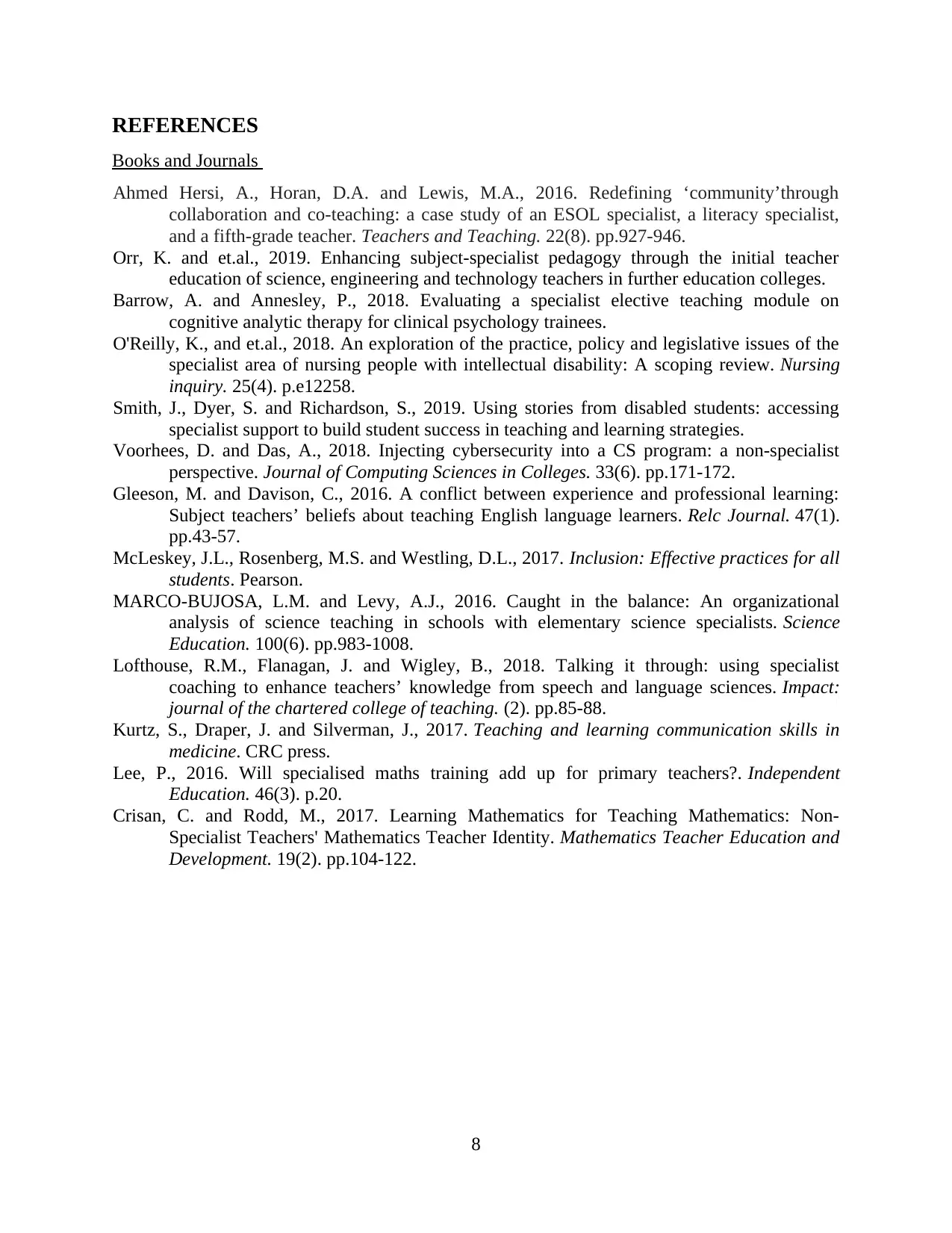
REFERENCES
Books and Journals
Ahmed Hersi, A., Horan, D.A. and Lewis, M.A., 2016. Redefining ‘community’through
collaboration and co-teaching: a case study of an ESOL specialist, a literacy specialist,
and a fifth-grade teacher. Teachers and Teaching. 22(8). pp.927-946.
Orr, K. and et.al., 2019. Enhancing subject-specialist pedagogy through the initial teacher
education of science, engineering and technology teachers in further education colleges.
Barrow, A. and Annesley, P., 2018. Evaluating a specialist elective teaching module on
cognitive analytic therapy for clinical psychology trainees.
O'Reilly, K., and et.al., 2018. An exploration of the practice, policy and legislative issues of the
specialist area of nursing people with intellectual disability: A scoping review. Nursing
inquiry. 25(4). p.e12258.
Smith, J., Dyer, S. and Richardson, S., 2019. Using stories from disabled students: accessing
specialist support to build student success in teaching and learning strategies.
Voorhees, D. and Das, A., 2018. Injecting cybersecurity into a CS program: a non-specialist
perspective. Journal of Computing Sciences in Colleges. 33(6). pp.171-172.
Gleeson, M. and Davison, C., 2016. A conflict between experience and professional learning:
Subject teachers’ beliefs about teaching English language learners. Relc Journal. 47(1).
pp.43-57.
McLeskey, J.L., Rosenberg, M.S. and Westling, D.L., 2017. Inclusion: Effective practices for all
students. Pearson.
MARCO‐BUJOSA, L.M. and Levy, A.J., 2016. Caught in the balance: An organizational
analysis of science teaching in schools with elementary science specialists. Science
Education. 100(6). pp.983-1008.
Lofthouse, R.M., Flanagan, J. and Wigley, B., 2018. Talking it through: using specialist
coaching to enhance teachers’ knowledge from speech and language sciences. Impact:
journal of the chartered college of teaching. (2). pp.85-88.
Kurtz, S., Draper, J. and Silverman, J., 2017. Teaching and learning communication skills in
medicine. CRC press.
Lee, P., 2016. Will specialised maths training add up for primary teachers?. Independent
Education. 46(3). p.20.
Crisan, C. and Rodd, M., 2017. Learning Mathematics for Teaching Mathematics: Non-
Specialist Teachers' Mathematics Teacher Identity. Mathematics Teacher Education and
Development. 19(2). pp.104-122.
8
Books and Journals
Ahmed Hersi, A., Horan, D.A. and Lewis, M.A., 2016. Redefining ‘community’through
collaboration and co-teaching: a case study of an ESOL specialist, a literacy specialist,
and a fifth-grade teacher. Teachers and Teaching. 22(8). pp.927-946.
Orr, K. and et.al., 2019. Enhancing subject-specialist pedagogy through the initial teacher
education of science, engineering and technology teachers in further education colleges.
Barrow, A. and Annesley, P., 2018. Evaluating a specialist elective teaching module on
cognitive analytic therapy for clinical psychology trainees.
O'Reilly, K., and et.al., 2018. An exploration of the practice, policy and legislative issues of the
specialist area of nursing people with intellectual disability: A scoping review. Nursing
inquiry. 25(4). p.e12258.
Smith, J., Dyer, S. and Richardson, S., 2019. Using stories from disabled students: accessing
specialist support to build student success in teaching and learning strategies.
Voorhees, D. and Das, A., 2018. Injecting cybersecurity into a CS program: a non-specialist
perspective. Journal of Computing Sciences in Colleges. 33(6). pp.171-172.
Gleeson, M. and Davison, C., 2016. A conflict between experience and professional learning:
Subject teachers’ beliefs about teaching English language learners. Relc Journal. 47(1).
pp.43-57.
McLeskey, J.L., Rosenberg, M.S. and Westling, D.L., 2017. Inclusion: Effective practices for all
students. Pearson.
MARCO‐BUJOSA, L.M. and Levy, A.J., 2016. Caught in the balance: An organizational
analysis of science teaching in schools with elementary science specialists. Science
Education. 100(6). pp.983-1008.
Lofthouse, R.M., Flanagan, J. and Wigley, B., 2018. Talking it through: using specialist
coaching to enhance teachers’ knowledge from speech and language sciences. Impact:
journal of the chartered college of teaching. (2). pp.85-88.
Kurtz, S., Draper, J. and Silverman, J., 2017. Teaching and learning communication skills in
medicine. CRC press.
Lee, P., 2016. Will specialised maths training add up for primary teachers?. Independent
Education. 46(3). p.20.
Crisan, C. and Rodd, M., 2017. Learning Mathematics for Teaching Mathematics: Non-
Specialist Teachers' Mathematics Teacher Identity. Mathematics Teacher Education and
Development. 19(2). pp.104-122.
8
Secure Best Marks with AI Grader
Need help grading? Try our AI Grader for instant feedback on your assignments.

9

10

11
Paraphrase This Document
Need a fresh take? Get an instant paraphrase of this document with our AI Paraphraser

12

13
1 out of 15
Related Documents
Your All-in-One AI-Powered Toolkit for Academic Success.
+13062052269
info@desklib.com
Available 24*7 on WhatsApp / Email
![[object Object]](/_next/static/media/star-bottom.7253800d.svg)
Unlock your academic potential
© 2024 | Zucol Services PVT LTD | All rights reserved.




